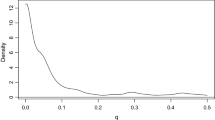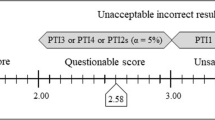Abstract
Numerical values called L-scores, with properties similar to those of z-scores, can be calculated for proficiency tests involving qualitative test methods. These scores do not require the use of replicates and are defined in such a way as to reflect both the Level of Competence of the Laboratory (LCL) and the Level of Difficulty of the Task (LDT). On the basis of the “logit” statistical model, the parameters corresponding to the LCL and the LDT values are determined via maximum likelihood estimation. With p denoting the corrected binary response, the model can be interpreted as \(\ln \left( {p/\left( {1 - p} \right)} \right) = LCL - LDT.\) The estimated parameters are then the quantities used to compute the L-scores for the participating laboratories. In the case of the laboratory-specific L-scores across tasks, the score for a particular laboratory can be computed as the deviation of the individual LCL from the average LCL relative to the standard error. The interpretation of the L-scores is slightly different from that of z-scores If |L| ≤ 2, the competence of the participant is not significantly different from the average competence. If L > 2, the competence is significantly higher, while if L < −2, the competence is significantly lower.

Similar content being viewed by others
References
ISO 13528 (2005) Statistical methods for use in proficiency testing by interlaboratory comparisons
Schilling P, Powilleit M, Uhlig S (2006) Macrozoobenthos interlaboratory comparison on taxonomical identification and counting of marine invertebrates in artificial sediment samples including testing various statistical methods of data evaluation. Accred Qual Assur 11:422–429
Nelder J, McCullagh P (1983) Generalized linear models. Chapman and Hall, Cambridge
Myers RH, Montgomery DC, Vining GG, Robinson TJ (2010) Generalized linear models with applications in engineering and the sciences. Wiley, Hoboken
PROLab POD. http://quodata.de/en/software/for-interlaboratory-tests/prolab.html. Accessed 06 June 2014
Acknowledgments
The example is based on anonymized data from Joint Action QUANDHIP. The authors would like to thank the reviewers for their helpful comments.
Author information
Authors and Affiliations
Corresponding author
Ethics declarations
Conflict of interest
The authors declare that there are no conflicts of interest.
Rights and permissions
About this article
Cite this article
Uhlig, S., Bläul, C., Frost, K. et al. Qualitative PT data analysis with easy-to-interpret scores. Accred Qual Assur 20, 347–353 (2015). https://doi.org/10.1007/s00769-015-1174-8
Received:
Accepted:
Published:
Issue Date:
DOI: https://doi.org/10.1007/s00769-015-1174-8




